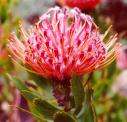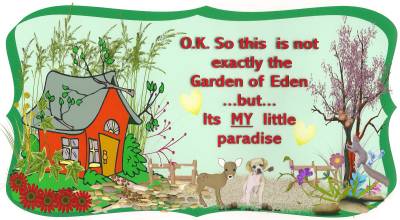Everything in your garden even gardening jokes and happy stories......






I don't like wearing gloves either, end up with cuts and splinters too.
NEW Gardeners' World presenter Monty Don (pictured) said he has always ignored advice which urges gardeners to wear gloves to protect them from deadly chemicals and nasty cuts.

Hi Attila - another friendly thread you've started. I too hate wearing gloves when gardening. When using bags of potting mix it always advises the user to wear gloves and a mask over the mouth. Watching those gardners on the T.V they never wear masks, I wonder why?

Best to dampen the potting mix in the bag before using so any of the nasties it may contain don't become airborne and inhaled if it is dry, was the advice I was given by a gardening expert. Sounds logical.

Hi Hola and Vivity. Yes potting mix needs to be moist, the issue is breathing in the nasties. I always remember one of our Govenors that became ill after gardening by breathing in matter.
Do you watch the ABC gardening programme? We like to watch but wish it was longer than 30 minutes.
http://www.abc.net.au/gardening/

Thank you Hola for your kind comment. I have always enjoyed gardening, I look at it as another form of painting only with colourful plants.
My enemy is the snail population together with the white butterflies. Especially this last week, I found catterpillars had eaten the heart of a lovely Kangaroo Paw plant! it is so sad, when I planted this Kangaroo Paw plant last winter she was really tall and colourful, it will teach me a lesson to keep my eye on the centre of these plants. Husband said he had put tomato dust on them, but I think it was old dust.
The Geraldton Wax is out in flower at the moment and it looks so pretty even in the rain it looks pretty with the rain droplets glistening in the sun.


I've always loved Geraldton Wax for incorporating into arrangements in a vase of flowers or in making flower bouquets for people.



Chester and Earl are going hunting….
Chester says to Earl, "I'll send my dog out to see if there are any ducks out in the pond. If there aren't many ducks out there, I'm not going hunting."
So he sends the dog out to the pond. The dog comes back and barks twice.
Chester says, "Well I'm not going to go out. He only saw two ducks out there."
Earl looks at Chester and skeptically says, "You're going to take the dog's barks for the truth are you?"
Obviously Earl doesn't believe it, so he goes to look for himself. When he gets back he says, "I don't believe it. There really are only two ducks out there!
Where did you get that dog"?
Chester says, "Well, I got him from the breeder up the road. If you want one, you can get one from him".
So Earl goes to the breeder and says he wants a dog like the one his friend Chester has. The breeder obliges and Earl brings the dog home, tells it to go out and look for ducks.
Minutes later the dog returns with a stick in its mouth and starts humping Earl's leg.
Outraged, Earl takes the dog back to the breeder and says, "This dog is a fraud. All he wants to do is play 'fetch a stick!' I want my money back!"
This concerned the breeder who asked Earl what the dog did.
So Earl tells him that when he sent the dog out to look for ducks, it came back with a stick in its mouth and started humping his leg.
The relieved breeder says, "Earl, dogs can't talk. He was trying to tell you there are more fucking ducks out there than you can shake a stick at!"

Raphael - I'll pay that one.

ha ha raphael, good one,


Have you notice the snails are wise to pellets these last couple of years? The older mature snails leave the pellets and I have to go hunting for them so they don't breed. Their youngsters are taking the bate though!
6 Easy Ways To Control Snails /GARDEN /PESTS & DISEASES /6 EASY WAYS TO CONTROL SNAILS
Here's how to protect your plants from snails and slugs

Snails and slugs love to eat leafy greens and seedlings
They eat their way through the garden under the cover of night, leaving a slimy trail to show where they’ve been.
A nocturnal menace to the garden in the warm months, snails and slugs have a huge appetite for many types of plants.
They love vegies, especially lettuce, but are happy to sample other delicacies from the spring garden smorgasbord.
Left unchecked they’ll attack flowers, with annuals like pansies and violas a favourite feast.
These pests like moist soil and are most active during cool weather and humid periods, so they’re especially busy in spring and early summer.
At night, snails and slugs climb onto plants to eat foliage, hiding in leaf debris or sheltering under shrubs during the day.
Signs of invasion
Before using pest control in the garden it’s essential to correctly identify the problem and use the appropriate technique or product.
If you know what to look for it’s easy to spot when gastropods are helping themselves to your plants.
Healthy seedlings can disappear overnight, plus foliage and flowers show ragged or chewed-looking holes with the lower leaves of plants usually consumed first.
Snails and slugs also leave a trail, so look for shiny streaks on foliage and silver-grey slime trails appearing on the plant, soil or pots.
The best way to catch them in the act is to search for them by torchlight, before sunrise or after dark.

Look for ragged or chewed leaves to find evidence of snailsMethods of control
The only sure-fire way to keep your garden free of snails and slugs is to destroy them. There are several ways to do this, or you can use natural deterrents to keep them away from your plants by making the garden less hospitable.
Poison
Scatter pellets or apply a snail gel around plants by hand, choosing an animal-friendly product to protect pets, native birds and lizards.
Bait
Set traps baited with fresh lettuce, citrus rind or stale beer, check them daily and squash the pests or drop them into a jar of salty water.
Shock
Use copper tape as a collar for young plants and pots, or as bed edging. Copper makes an effective barrier, as it gives snails and slugs a slight electric shock. This tape is about 30mm wide.
Catch
Search and destroy snails and slugs by hand-picking them out of the garden and killing them. If you can’t bear to squash or drown them, mix a solution of equal parts vinegar and water and pour it into a spray bottle for a homemade and eco-friendly pesticide. Spray the solution directly onto both snails and slugs to kill them, but be careful where you use it as vinegar is a herbicide and will also poison your plants.
Deter
Position timber boards on the soil near vulnerable plants and the pests will migrate to the underside where they can be easily removed. Clear away decaying vegetation and debris like rocks and leaf litter to eliminate daytime hiding places. Mulch also makes a good home for snails and slugs, so keep it less than 80mm thick.
TIP Don’t spread mulch until plants are well established and daytime temperatures are reaching 21°C.
Block
Lay barriers around plants, especially lettuces, to stop snails and slugs in their tracks. These soft-bodied pests will turn away from a sharp or scratchy barrier rather then crawl across it to get to the salad bar. Surround plants with strips of coarse grit abrasive paper or broken eggshells. Coir also works, as the tiny fibres stick to snails and slugs, making it hard for them to move.
Make a beer bait
Slugs and snails are attracted to the sweet, yeasty combination of sugar and beer, making it the ideal bait.
Sink a shallow bowl or tub in the ground with the rim at soil level.Stir a pinch of sugar into 150ml of stale beer then pour the mixture into the bowl to a depth of 30mm. The pests will crawl into the beer for a drink and drown.Empty and refill the baits every two days.

A homemade beer bait is effective at killing snails
6 Easy Ways To Control Snails / GARDEN / PESTS & DISEASES / 6 EASY WAYS TO CONTROL SNAILS
Here's how to protect your plants from snails and slugs Snails and slugs love to eat leafy greens and seedlings They eat their way through the garden under the cover of night, leaving a slimy trail to show where they’ve been. A nocturnal menace to the garden in the warm months, snails and slugs have a huge appetite for many types of plants. They love vegies, especially lettuce, but are happy to sample other delicacies from the spring garden smorgasbord. Left unchecked they’ll attack flowers, with annuals like pansies and violas a favourite feast. These pests like moist soil and are most active during cool weather and humid periods, so they’re especially busy in spring and early summer. At night, snails and slugs climb onto plants to eat foliage, hiding in leaf debris or sheltering under shrubs during the day. Signs of invasion Before using pest control in the garden it’s essential to correctly identify the problem and use the appropriate technique or product. If you know what to look for it’s easy to spot when gastropods are helping themselves to your plants. Healthy seedlings can disappear overnight, plus foliage and flowers show ragged or chewed-looking holes with the lower leaves of plants usually consumed first. Snails and slugs also leave a trail, so look for shiny streaks on foliage and silver-grey slime trails appearing on the plant, soil or pots. The best way to catch them in the act is to search for them by torchlight, before sunrise or after dark. Look for ragged or chewed leaves to find evidence of snails Methods of control The only sure-fire way to keep your garden free of snails and slugs is to destroy them. There are several ways to do this, or you can use natural deterrents to keep them away from your plants by making the garden less hospitable. Poison Scatter pellets or apply a snail gel around plants by hand, choosing an animal-friendly product to protect pets, native birds and lizards. Bait Set traps baited with fresh lettuce, citrus rind or stale beer, check them daily and squash the pests or drop them into a jar of salty water. Shock Use copper tape as a collar for young plants and pots, or as bed edging. Copper makes an effective barrier, as it gives snails and slugs a slight electric shock. This tape is about 30mm wide. Catch Search and destroy snails and slugs by hand-picking them out of the garden and killing them. If you can’t bear to squash or drown them, mix a solution of equal parts vinegar and water and pour it into a spray bottle for a homemade and eco-friendly pesticide. Spray the solution directly onto both snails and slugs to kill them, but be careful where you use it as vinegar is a herbicide and will also poison your plants. Deter Position timber boards on the soil near vulnerable plants and the pests will migrate to the underside where they can be easily removed. Clear away decaying vegetation and debris like rocks and leaf litter to eliminate daytime hiding places. Mulch also makes a good home for snails and slugs, so keep it less than 80mm thick. TIP Don’t spread mulch until plants are well established and daytime temperatures are reaching 21°C. Block Lay barriers around plants, especially lettuces, to stop snails and slugs in their tracks. These soft-bodied pests will turn away from a sharp or scratchy barrier rather then crawl across it to get to the salad bar. Surround plants with strips of coarse grit abrasive paper or broken eggshells. Coir also works, as the tiny fibres stick to snails and slugs, making it hard for them to move. Make a beer bait Slugs and snails are attracted to the sweet, yeasty combination of sugar and beer, making it the ideal bait. Sink a shallow bowl or tub in the ground with the rim at soil level. Stir a pinch of sugar into 150ml of stale beer then pour the mixture into the bowl to a depth of 30mm. The pests will crawl into the beer for a drink and drown. Empty and refill the baits every two days. A homemade beer bait is effective at killing snails













